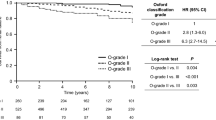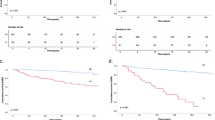Abstract
Background. A beneficial effect of steroid therapy for IgA nephropathy (IgAN) has been reported. However, precise histological criteria for steroid therapy have not yet been established. The present study was designed to assess the clinical validity of histological grading and staging for predicting the responsiveness to steroid therapy in IgAN.
Methods. We performed a retrospective study of 27 patients with IgAN who underwent steroid therapy. The duration of steroid therapy was 42.9 ± 23.1 months, and the mean follow-up period was 7.5 ± 2.4 years, ranging from 4 to 14 years. Responsiveness to the steroid therapy was evaluated by reduction of urinary protein at 1 year after treatment; more than 50% reduction of initial urinary protein and less than 1.0 g/day. Responsiveness to the therapy was also evaluated by preservation of renal function; i.e., maintenance of serum creatinine level under 2.0 mg/dl during follow-up. The histological grading and staging method (G-S system) proposed by Shigematsu was used to evaluate the histological severity of lesions in renal biopsy specimens. Univariate analyses of clinical and histological parameters, using the logistic regression model or Cox proportional hazards model, were performed to find predictive factors for the effectiveness of steroid therapy.
Results. No clinical parameters at the start of treatment predicted the effectiveness of the steroid therapy. However, some histological parameters – crescent formation rate (%), grade of glomerular extracapillary lesions (Gex) and grades of acute and chronic interstitial inflammation (Gint and Sint) – were predictive for the effectiveness of steroid therapy. To predict reduction of proteinuria at 1 year after steroid therapy, the crescent formation rate, Gex, Gint, and Sint were significant (odds ratio; P value): crescent formation rate per 10% increment (2.91; P = 0.019), Gex per 0.1 grade increment (1.56; P = 0.021), Gint per one grade increment (0.20; P = 0.022), and Sint per one grade increment (0.33; P = 0.039). These results indicated that a high crescent formation rate and active extracapillary lesions predicted favorable response, and active and chronic interstitial lesions predicted lower efficacy in proteinuria reduction. To predict deterioration of renal function, Gint and Sint were significant (hazard ratio; P value): Gint per one grade increment (3.30; P = 0.015) and Sint per one grade increment (2.99; P = 0.006), indicating that high degrees of acute and chronic interstitial inflammation predicted the deterioration of renal function.
Conclusions. The severity of acute glomerular extracapillary lesions predicts the possibility of reduction in proteinuria after steroid therapy, while the severity of interstitial inflammation suggests a lower efficacy for proteinuria reduction and a high risk of renal dysfunction even after steroid therapy in IgAN.
Similar content being viewed by others
Author information
Authors and Affiliations
Additional information
Received: August 17, 1999 / Accepted: May 8, 2000
About this article
Cite this article
Honda, K., Nitta, K., Kobayashi, H. et al. Clinical significance of histological grading and staging for predicting the effectiveness of steroid therapy in IgA nephropathy. Clin Exp Nephrol 4, 241–250 (2000). https://doi.org/10.1007/s101570070029
Issue Date:
DOI: https://doi.org/10.1007/s101570070029




